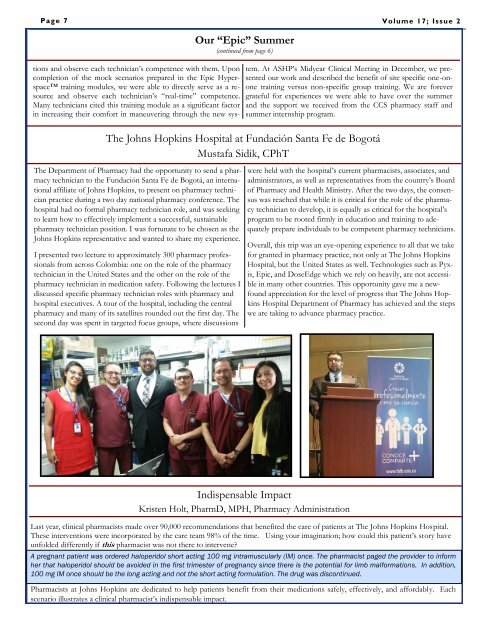WOW February 2017
Granisetron Transdermal System
Granisetron Transdermal System
You also want an ePaper? Increase the reach of your titles
YUMPU automatically turns print PDFs into web optimized ePapers that Google loves.
Page 7 Volume 17; Issue 2<br />
Our “Epic” Summer<br />
(continued from page 6)<br />
tions and observe each technician’s competence with them. Upon<br />
completion of the mock scenarios prepared in the Epic Hyperspace<br />
training modules, we were able to directly serve as a resource<br />
and observe each technician’s “real-time” competence.<br />
Many technicians cited this training module as a significant factor<br />
in increasing their comfort in maneuvering through the new system.<br />
At ASHP’s Midyear Clinical Meeting in December, we presented<br />
our work and described the benefit of site specific one-onone<br />
training versus non-specific group training. We are forever<br />
grateful for experiences we were able to have over the summer<br />
and the support we received from the CCS pharmacy staff and<br />
summer internship program.<br />
The Johns Hopkins Hospital at Fundación Santa Fe de Bogotá<br />
Mustafa Sidik, CPhT<br />
The Department of Pharmacy had the opportunity to send a pharmacy<br />
technician to the Fundación Santa Fe de Bogotá, an international<br />
affiliate of Johns Hopkins, to present on pharmacy technician<br />
practice during a two day national pharmacy conference. The<br />
hospital had no formal pharmacy technician role, and was seeking<br />
to learn how to effectively implement a successful, sustainable<br />
pharmacy technician position. I was fortunate to be chosen as the<br />
Johns Hopkins representative and wanted to share my experience.<br />
I presented two lecture to approximately 300 pharmacy professionals<br />
from across Colombia: one on the role of the pharmacy<br />
technician in the United States and the other on the role of the<br />
pharmacy technician in medication safety. Following the lectures I<br />
discussed specific pharmacy technician roles with pharmacy and<br />
hospital executives. A tour of the hospital, including the central<br />
pharmacy and many of its satellites rounded out the first day. The<br />
second day was spent in targeted focus groups, where discussions<br />
were held with the hospital’s current pharmacists, associates, and<br />
administrators, as well as representatives from the country’s Board<br />
of Pharmacy and Health Ministry. After the two days, the consensus<br />
was reached that while it is critical for the role of the pharmacy<br />
technician to develop, it is equally as critical for the hospital’s<br />
program to be rooted firmly in education and training to adequately<br />
prepare individuals to be competent pharmacy technicians.<br />
Overall, this trip was an eye-opening experience to all that we take<br />
for granted in pharmacy practice, not only at The Johns Hopkins<br />
Hospital, but the United States as well. Technologies such as Pyxis,<br />
Epic, and DoseEdge which we rely on heavily, are not accessible<br />
in many other countries. This opportunity gave me a newfound<br />
appreciation for the level of progress that The Johns Hopkins<br />
Hospital Department of Pharmacy has achieved and the steps<br />
we are taking to advance pharmacy practice.<br />
Indispensable Impact<br />
Kristen Holt, PharmD, MPH, Pharmacy Administration<br />
Last year, clinical pharmacists made over 90,000 recommendations that benefited the care of patients at The Johns Hopkins Hospital.<br />
These interventions were incorporated by the care team 98% of the time. Using your imagination; how could this patient’s story have<br />
unfolded differently if this pharmacist was not there to intervene?<br />
A pregnant patient was ordered haloperidol short acting 100 mg intramuscularly (IM) once. The pharmacist paged the provider to inform<br />
her that haloperidol should be avoided in the first trimester of pregnancy since there is the potential for limb malformations. In addition,<br />
100 mg IM once should be the long acting and not the short acting formulation. The drug was discontinued.<br />
Pharmacists at Johns Hopkins are dedicated to help patients benefit from their medications safely, effectively, and affordably. Each<br />
scenario illustrates a clinical pharmacist’s indispensable impact.


